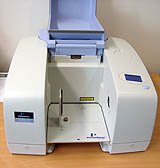Rotation-Vibration Spectra of Molecules
Supervisor: Dr. Chris Sturm
 The
investigation of rotation-vibration spectra is done on a
diatomic molecule (HCl). The theoretical treatment is done in
the framework of quantum mechanics with help of the so-called
dumbbell model. The interaction of the oscillator and the
rotator is included. Due to the precision and the spectral
resolving power of the spectrometer it is possible to measure
the rotational constant in dependence on the vibrational
quantum number. Besides the influence of the chlorine isotopes
on the spectrum may be investigated. The dependence of the
intensity of the lines on the wave number has to be calculated
for the interpretation of the Bjerrums double bands. The
parameters of the used spectrometer (resolving power, stray
light) have to be determined.
The
investigation of rotation-vibration spectra is done on a
diatomic molecule (HCl). The theoretical treatment is done in
the framework of quantum mechanics with help of the so-called
dumbbell model. The interaction of the oscillator and the
rotator is included. Due to the precision and the spectral
resolving power of the spectrometer it is possible to measure
the rotational constant in dependence on the vibrational
quantum number. Besides the influence of the chlorine isotopes
on the spectrum may be investigated. The dependence of the
intensity of the lines on the wave number has to be calculated
for the interpretation of the Bjerrums double bands. The
parameters of the used spectrometer (resolving power, stray
light) have to be determined.
- Experimental determination of the vibration wave number, of the rotational constant, and of the distance between the ions
- Influence of the isotopes on the spectra
- Dumbbell model (quantum mechanical treatment)
- Interaction between oscillator and rotator
- Basics of infrared spectroscopy

